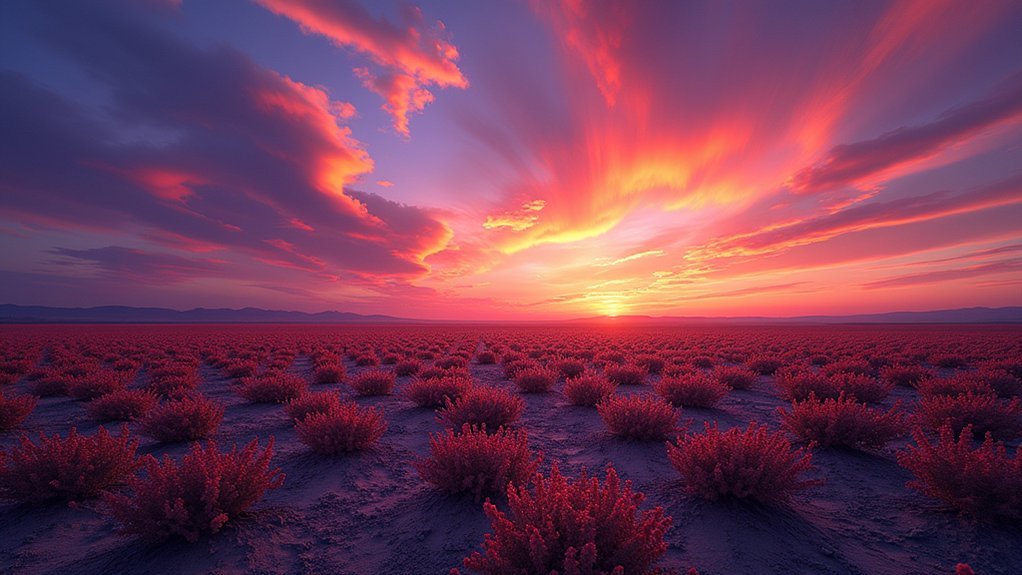For scientific time-lapse imaging, use uncompressed TIFF or OME-TIFF formats. They preserve exact pixel values without compression artifacts and maintain critical metadata including timestamps, exposure settings, and dimensional information. Avoid JPEG, which compromises data integrity through lossy compression. When storage space is limited, consider lossless PNG compression. Organize files with consistent naming conventions for efficient browsing. The right format choice guarantees your research remains reproducible and analytically sound for years to come.
Understanding Time-Lapse Imaging Data Structure

When you’re working with time-lapse imaging, it’s essential to grasp the underlying data structure that makes these fascinating sequences possible. Time-lapse data consists of sequential images captured at predetermined intervals, each preserving critical metadata such as timestamps and exposure settings.
For meaningful analysis, you’ll need file formats that maintain both image quality and metadata integrity. TIFF or OME-TIFF formats are ideal since they preserve exact pixel values without compression artifacts. Unlike JPEGs, which use lossy compression that can corrupt your data, these formats guarantee analytical accuracy.
Consider organizing your files with consistent naming conventions and using virtual stacks for browsing large datasets efficiently. This approach prevents memory overload when working with high-resolution images while keeping all important information accessible for precise time-based analysis.
Essential Metadata for Scientific Time-Lapse Sequences
Beyond choosing the right file format, proper documentation of metadata transforms your time-lapse sequences from mere visual records into valuable scientific data.
When capturing time-lapse imagery, you’ll need to record essential parameters including image dimensions, bit-depths, pixel sizes, and microscope settings to guarantee accurate analysis.
Always include precise timestamps for each frame to enable proper temporal analysis of dynamic processes. Document your camera specifications and imaging settings (exposure time, gain) to support reproducibility.
Specify which file format you’ve used, as this affects how pixel values and metadata are preserved. For data integrity, note any processing steps applied to your images, such as cropping or filtering.
This transparency guarantees your time-lapse sequences remain scientifically valid and interpretable by colleagues reviewing your work.
Uncompressed vs. Compressed Time-Lapse Formats

Choosing between uncompressed and compressed formats represents one of the most critical decisions you’ll make when creating scientific time-lapse sequences.
Uncompressed formats like TIFF preserve all pixel values and metadata essential for scientific analysis, ensuring complete data integrity.
Compressed formats fall into two categories: lossy (like JPEG) which sacrifice data quality for smaller file sizes, creating artifacts that compromise analysis; and lossless compression, which reduces size while maintaining original pixel values. For scientific imaging, avoid lossy compression whenever possible.
Consider storage requirements carefully – an 8-bit uncompressed image requires 1MB per million pixels, while 16-bit versions double that space.
For most scientific applications, OME-TIFF offers an ideal solution, combining TIFF’s lossless storage with standardized metadata architecture that supports thorough analysis requirements.
TIFF Series: Preserving Data Integrity in Time-Lapse
TIFF series formats offer you unrivaled data integrity by preserving exact pixel values across all frames of your time-lapse imaging projects.
You’ll benefit from extensive metadata tagging capabilities that track essential experimental parameters and facilitate reproducibility in scientific work.
The batch processing efficiency of TIFF files allows you to analyze multiple time points simultaneously while maintaining consistent quality standards across your entire dataset.
Lossless Data Preservation
When scientific precision matters in your time-lapse projects, the TIFF format stands as the gold standard for data preservation.
Unlike lossy formats that compromise image quality, TIFF maintains complete pixel values and extensive metadata essential for accurate scientific imaging analysis.
You’ll find that 16-bit TIFF images capture considerably more detail than 8-bit alternatives, providing better gradient representation and color depth.
This preservation guarantees your time-lapse studies retain all critical data points for measurement and interpretation.
Metadata Tagging Benefits
Beyond raw pixel data, the metadata embedded within TIFF files serves as a vital foundation for scientific time-lapse integrity. When you work with TIFF formats, you’re preserving essential acquisition parameters that directly impact your analysis outcomes.
The specialized OME-TIFF variant enhances this capability by standardizing microscopy settings, dimensional data, and imaging conditions.
You’ll avoid significant analytical errors by maintaining original TIFF files rather than converting to formats like JPEG, which strip away vital metadata. This retention guarantees you can accurately trace experimental conditions and validate results.
With support for 8, 16, and 32-bit depths, TIFF accommodates various scientific imaging needs while maintaining data integrity. Remember, missing metadata can lead to measurement errors—the thorough tagging system in TIFF safeguards your research from such pitfalls.
Batch Processing Efficiency
Processing thousands of images efficiently becomes possible with properly structured TIFF series for your time-lapse projects.
When you organize scientific imaging data in TIFF format, you’ll maintain essential pixel values and metadata integrity throughout batch processing workflows.
Your image analysis pipeline benefits from TIFF’s compatibility with specialized software like ImageJ and QuPath, which are optimized for handling large datasets.
You’ll appreciate how TIFF files preserve original bit-depth (8, 16, or 32-bit) across every frame, ensuring accurate data representation without quality loss.
For extensive time-lapse experiments, utilize TIFF’s lossless compression options to reduce storage requirements while preserving image fidelity.
This format’s structured approach to metadata management supports reproducibility in scientific research, making TIFF the superior choice when processing sequences requiring absolute data integrity.
OME-TIFF: The Gold Standard for Scientific Reproducibility
Among serious scientific imaging formats, OME-TIFF stands as the undisputed gold standard for researchers who require absolute data integrity and reproducibility. When you’re working with microscopy images that contain multiple dimensions—channels, z-stacks, and time points—OME-TIFF preserves everything in a single file without compromising pixel values.
What sets this format apart is its thorough metadata framework that captures critical details about your imaging conditions, instruments, and samples.
You’ll appreciate that OME-TIFF files work seamlessly across popular bioimaging software like ImageJ and QuPath, eliminating cross-platform compatibility issues when sharing datasets with colleagues.
For time-lapse experiments where quantitative analysis is essential, you can’t afford compression-related data loss. OME-TIFF guarantees your scientific research remains precise, verifiable, and accessible to the broader scientific community.
Proprietary Formats: Advantages and Limitations

While proprietary formats like ND2 and CZI preserve rich metadata essential for your time-lapse analysis, you’ll face significant challenges when converting these files to other formats without losing critical information.
You’re often limited to specific software platforms that can properly read these formats, creating potential compatibility barriers when sharing data with colleagues.
When planning your imaging workflow, consider whether the advanced features of proprietary formats outweigh the accessibility limitations they impose on your long-term data management strategy.
Proprietary Format Conversion Challenges
Converting proprietary formats like ND2 and CZI presents significant hurdles for time-lapse imaging workflows.
When you transform these files to more universal formats like TIFF, you’ll often sacrifice essential metadata that’s vital for proper analysis. This conversion process can compromise your research integrity if not handled carefully.
- Lossy compression during conversion may introduce artifacts and degrade image quality, affecting measurement accuracy.
- Important metadata like acquisition parameters, calibration data, and experimental conditions can be lost.
- Interoperability issues arise when software can’t fully interpret converted files.
- Data retention becomes problematic for long-term archiving, potentially impacting reproducibility.
You’ll need to weigh these challenges against accessibility benefits, especially when collaborating with colleagues using different analysis platforms.
Metadata Preservation Issues
Proprietary formats create a double-edged sword for time-lapse imaging scientists, offering robust metadata retention but limiting accessibility. When you work with formats like ND2, LIF, and CZI, you’re preserving essential acquisition parameters and dimensional information that’s vital for accurate image data interpretation.
Converting to general formats like JPEG strips away this rich metadata, potentially compromising your research reproducibility. While proprietary formats maintain pixel values with high fidelity, they often require specific software for analysis, creating data sharing barriers when collaborators lack necessary licenses.
You’ll face a significant decision: maintain complete metadata in proprietary formats or sacrifice information for wider accessibility.
The safest approach is retaining original files for reference while creating standardized versions for sharing—ensuring you don’t permanently lose the metadata that contextualizes your time-lapse experiments.
Limited Software Compatibility
When selecting formats for your time-lapse projects, you’ll inevitably face tradeoffs between advanced features and universal access. Proprietary formats like ND2, LIF, and CZI excel at metadata preservation and image quality optimization but create significant software compatibility challenges.
- Specialized viewing software requirements limit accessibility, especially in collaborative settings where colleagues may lack necessary licenses.
- Long-term data preservation becomes risky as proprietary software updates may abandon support for older file versions.
- Scientific imaging collaborations suffer when team members can’t access or analyze data without specific software platforms.
- While proprietary formats offer enhanced capabilities for specific hardware, these benefits come at the cost of reduced compatibility with general-purpose analysis tools.
When deciding between proprietary and open formats, carefully assess how your workflow prioritizes advanced features versus broad accessibility requirements.
Converting Between Time-Lapse File Formats

Although researchers often capture time-lapse sequences in one format, you’ll frequently need to convert them to another for analysis, sharing, or archiving. When converting time-lapse files, prioritize formats that preserve both pixel values and metadata—OME-TIFF excels here for scientific imaging.
| Format Type | Considerations |
|---|---|
| OME-TIFF | Preserves standardized metadata; recommended for scientific use |
| Lossy (JPEG) | Avoid; introduces artifacts and data loss |
| Raw Formats | Maintains bit-depth; critical for fluorescence microscopy |
| Video Codecs | Select lossless options for scientific work |
| Proprietary | Check software compatibility before converting |
Always verify your converted files by reopening them to confirm that metadata and pixel values remain intact. Use batch processing software that offers specific frame rate settings to optimize your workflow.
Storage Considerations for Long-Duration Time-Lapse
You’ll need to balance raw file quality against practical storage limitations when capturing extended time-lapse sequences.
Selecting memory-efficient formats like PNG with lossless compression can greatly reduce your storage requirements while preserving essential image data.
When working with particularly massive datasets, consider implementing pyramidal storage structures or virtual stacking techniques that allow you to access only the portions of data you currently need.
Memory-Efficient Format Selection
Selecting the right file format becomes critical as your time-lapse project extends over longer durations, directly impacting both storage requirements and workflow efficiency.
While uncompressed formats preserve complete pixel values, they quickly consume storage space. Consider OME-TIFF when scientific precision matters—it offers lossless compression while maintaining essential metadata for analysis.
- Balance image quality with file size by choosing 8-bit over 16-bit capture when appropriate
- Implement virtual stacks to load only necessary image slices rather than entire datasets
- Use compressed formats for preliminary work, reserving uncompressed formats for final analysis
- Consider OME-TIFF as your primary format for scientific imaging where both data integrity and storage efficiency matter
Raw vs. Compressed Tradeoffs
Long-duration time-lapse projects create a fundamental tension between image quality and storage capacity. You’ll need to balance preserving scientific data against managing growing datasets.
| Format Type | Storage Impact | Data Integrity |
|---|---|---|
| Raw | Highest space usage | Complete preservation of metadata and pixel values |
| Lossless (PNG/TIFF) | Moderate space usage | Full image quality with some compression |
| Lossy (JPEG) | Lowest space usage | Loss of data and potential artifacts |
| Pyramidal | Variable | Maintains quality while improving access speed |
Raw image formats preserve every detail needed for precise measurement but quickly consume storage space. Lossy compression considerably reduces file sizes but introduces artifacts that compromise scientific analysis. Consider lossless compression as a middle ground—you’ll maintain image quality and essential metadata while achieving reasonable storage efficiency for extended time-lapse sequences.
Optimizing File Formats for Analysis Software

When processing time-lapse data through analysis software, the file format you choose can markedly impact your results’ accuracy and reliability. OME-TIFF stands as the preferred format for scientific imaging as it preserves both pixel values and standardized metadata critical for reproducible analysis.
While microscopy formats like ND2, LIF, and CZI excellently maintain acquisition settings, they may require specific software for access.
- Save in uncompressed TIFF format when using ImageJ to preserve all dimensional data
- Avoid JPEG compression which introduces artifacts that compromise quantitative measurements
- Verify your chosen format reopens correctly with all metadata intact
- Consider virtual stacks for efficiently handling large datasets without sacrificing image quality
Presentation-Ready Time-Lapse Export Options
While analysis demands meticulous attention to data integrity, the final presentation of your time-lapse project requires formats optimized for viewing and sharing.
For presentation-ready exports, MP4 and MOV formats are ideal choices due to their universal compatibility and efficient compression.
When exporting your time-lapse, the H.264 codec offers an excellent balance between quality and file sizes, making your content suitable for both presentations and online distribution.
If you’re using Adobe Premiere Pro or ffmpeg, customize resolution and bitrate settings to match your presentation needs.
For projects where scientific integrity is paramount, consider formats that preserve metadata.
Though uncompressed AVI maintains maximum quality, the resulting large file sizes may be impractical.
OME-TIFF offers a compromise for still frames, retaining critical metadata while ensuring presentation functionality.
Future-Proofing Your Time-Lapse Data
Creating time-lapse sequences that remain accessible and analyzable for years requires strategic planning beyond immediate project needs. By prioritizing lossless formats like TIFF or OME-TIFF, you’ll preserve original pixel values essential for future analysis.
Scientific imaging evolves rapidly, so your storage practices must adapt accordingly.
- Save original images in lossless formats that maintain complete metadata and acquisition parameters.
- Implement virtual stacks for efficient browsing of large time-lapse data collections.
- Establish multiple backup locations using different storage technologies for redundancy.
- Document thorough metadata including dimensions, bit-depth, and imaging conditions.
Regularly updating your workflow to accommodate emerging technologies guarantees your valuable time-lapse data remains viable even as analysis tools advance.
Remember that today’s archiving decisions determine tomorrow’s research possibilities.
Frequently Asked Questions
What Is the Best File Format for High Quality Images?
For high quality images, you’ll want to use TIFF format. It supports various bit depths and lossless compression, ensuring you don’t lose pixel data. It’s ideal when precision matters in your work.
What Is the Best Image Format for Scientific Paper?
For scientific papers, you’ll want to use vector formats (.pdf, .eps) for line art and diagrams, and TIFF for photographic images. Always check your target journal’s specific requirements before finalizing your submission.
What Is the Best Software for Time-Lapse?
For time-lapse creation, your best option depends on your skill level. Lightroom with LRTimelapse offers user-friendly editing, while ffmpeg provides powerful customization. Beginners might prefer Avidemux’s simplicity or VirtualDub’s straightforward interface.
What Is the Timelapse Program for Camera Traps?
Timelapse is a specialized software for camera trap research. You’ll find it efficiently extracts metadata, categorizes images, provides customized data entry interfaces, and offers visual search tools for wildlife analysis.
In Summary
You’ll need to weigh data integrity against storage constraints when selecting time-lapse formats. OME-TIFF and TIFF series remain your best options for preserving raw scientific data, while MP4 or other compressed formats work for presentations. Always include thorough metadata and consider future compatibility. By choosing the right format for your specific workflow, you’ll guarantee your valuable time-lapse data remains accessible and scientifically valid for years to come.





Leave a Reply